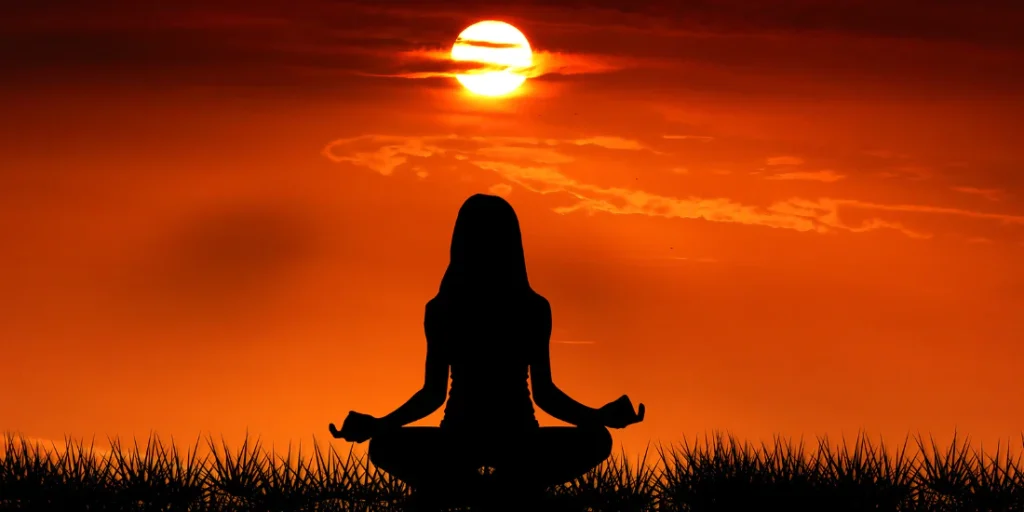
In the hustle and bustle of our modern lives, finding a sense of inner peace can seem like an elusive dream. The demands of work, family, and personal responsibilities often leave us feeling overwhelmed and stressed. But fear not, for there is a powerful tool at your disposal meditation. This ancient practice has been helping individuals across the globe find solace and harmony within themselves. In this article, we will delve into the art of meditation, exploring its numerous benefits and offering guidance on how to make it a consistent part of your daily routine.
The Power of Meditation: A Closer Look
Meditation, a practice that dates back thousands of years, is more than just a relaxation technique; it’s a journey towards inner peace. At its core, meditation is a way to turn your attention inward, to focus on the present moment, and to achieve a state of mental clarity. It’s about creating a harmonious relationship between your mind, body, and soul.
Meditation offers a plethora of physical and mental health benefits. From stress reduction to improved concentration, its advantages are not to be underestimated. Let’s take a closer look at some of the remarkable benefits of meditation.
Stress Reduction: The Key to Inner Harmony
Stress is an unwelcome companion for many of us, and it can take a significant toll on our overall well-being. Meditation, however, has been proven to be an effective tool for reducing stress. By practicing meditation regularly, you can learn to manage stress better and ultimately find that elusive inner peace.
Meditation works by activating the relaxation response in your body, which counters the stress-induced fight or flight response. When you meditate, you allow your body to enter a state of deep relaxation, leading to reduced heart rate, lower blood pressure, and decreased levels of the stress hormone cortisol. This, in turn, helps you to cultivate a sense of calm and harmony within.
Improved Focus and Concentration: A Clarity of Mind
In today’s world of constant distractions and information overload, maintaining focus and concentration can be challenging. Meditation can be a game-changer in this aspect. Through mindfulness meditation, you can train your mind to stay in the present moment, improving your ability to concentrate on the tasks at hand.
By regularly practicing meditation, you enhance your attention span and cognitive functions. This newfound mental clarity allows you to tackle challenges with a calm and focused mind, fostering a deeper sense of inner peace.
Emotional Well-being: A Path to Self-Discovery
Meditation is not only about calming the mind; it’s also about delving into your inner world. It provides an opportunity for self-reflection and self-discovery. When you meditate, you become more in tune with your emotions and thoughts.
This self-awareness can lead to greater emotional well-being. You’ll gain insights into your thought patterns and emotional responses, which can help you address and overcome negative emotions like anger, anxiety, and depression. As you navigate your emotional landscape, you’ll find a newfound sense of harmony within yourself.
Enhanced Physical Health: The Mind-Body Connection
The benefits of meditation aren’t confined to your mental and emotional well-being; they extend to your physical health as well. The mind-body connection is a powerful one, and meditation can strengthen this connection.
Through meditation, you can lower your blood pressure, boost your immune system, and even improve your sleep quality. These physical benefits contribute to your overall sense of well-being and inner peace.

Making Meditation a Part of Your Daily Routine
Now that we’ve explored the remarkable benefits of meditation, you might be wondering how to incorporate this practice into your daily life. Here are some practical steps to help you get started on your journey to inner peace:
Find a Quiet Space:
Choose a peaceful and quiet space where you won’t be disturbed during your meditation. This could be a corner of your bedroom, a tranquil park, or any place that makes you feel comfortable.
Set a Regular Time:
Consistency is key when it comes to meditation. Set aside a specific time each day for your practice. Whether it’s in the morning to start your day off right or in the evening to wind down, having a regular meditation schedule helps you make it a habit.
Begin with Short Sessions:
If you’re new to meditation, start with short sessions, around 5-10 minutes. As you become more comfortable with the practice, you can gradually extend your meditation time.
Focus on Your Breath:
A fundamental meditation technique is to concentrate on your breath. Take slow, deep breaths and observe the sensation of your breath as it enters and exits your body. This helps anchor your attention to the present moment.
Mindful Meditation:
Mindfulness meditation involves observing your thoughts without judgment. Let your thoughts flow naturally without trying to control them. This practice can lead to greater self-awareness and emotional balance.
Guided Meditation:
Consider using guided meditation sessions to assist you, especially if you’re just starting. You can find a variety of guided meditations online or through meditation apps.
Be Patient with Yourself:
Remember that meditation is a skill that improves with time. Be patient and compassionate with yourself as you embark on this journey. Don’t be discouraged by a busy mind or occasional distractions.
Maintaining Consistency: The Key to Meditation Success
While understanding the benefits of meditation is crucial, achieving inner peace through this practice requires consistency. Let’s explore strategies to ensure you stay committed to your meditation journey.
Keep a Meditation Journal:
Recording your meditation experiences can be a powerful motivator. Jot down your thoughts, feelings, and any insights you gain during your meditation sessions. This journal can serve as a source of inspiration and a reminder of your progress.
Set Realistic Goals:
Define achievable goals for your meditation practice. Whether it’s meditating for a certain number of days in a row or extending your session duration, setting targets can help keep you motivated.
Create a Relaxing Atmosphere:
Enhance your meditation experience by creating a soothing atmosphere. Consider using soft lighting, calming scents like lavender or sandalwood, comfortable cushions, or a meditation chair to make your space as inviting as possible.
Explore Different Techniques:
There are various meditation techniques to choose from, including mindfulness, loving-kindness, body scan, and more. Don’t be afraid to explore different methods to find the one that resonates most with you meditate with a Group:
Joining a meditation group or attending guided meditation classes can provide additional motivation. Meditating with others can create a sense of accountability and a shared commitment to inner peace.
Navigating Common Meditation Challenges
Meditation, while a transformative practice, is not without its challenges. Let’s address some common hurdles that may arise on your meditation journey and provide strategies to overcome them.
Restless Mind:
It’s common for your mind to wander during meditation. When this happens, gently bring your focus back to your breath or chosen point of concentration. Over time, your ability to maintain focus will improve.
Impatience:
You may feel impatient, expecting instant results from meditation. Remember that meditation is a gradual process, and its benefits become apparent over time. Trust in the journey and patience will be your ally.
Resistance to Routine:
MainDaily meditation be challenging, especially with a busy schedule. Consider incorporating meditation into your daily routine by associating it with an existing habit, like right after waking up or before bedtime.
Physical Discomfort:
If you experience physical discomfort during meditation, such as stiffness or pain, experiment with different sitting positions or use supportive props. The goal is to find a comfortable posture that allows you to focus on your practice.
Perceived Lack of Time:
Feeling like you have no time for meditation is a common concern. Start with shorter sessions and gradually increase the duration as you become more comfortable with the practice. Even a few minutes of meditation can be beneficial.
The Future of Inner Peace: A Lifelong Journey
Meditation is not a quick fix but a lifelong journey towards inner peace. It’s a process of self-discovery and transformation. As you continue to meditate and navigate the challenges that may arise, remember that inner peace is not a destination but a state of being that evolves with time and practice.
Each day you spend in meditation is a step closer to achieving greater harmony within yourself. Embrace the journey, celebrate your progress, and maintain the understanding that inner peace is attainable through dedication and self-compassion.
A Guided Journey to Inner Peace Begins with You
In the pursuit of inner peace, meditation stands as a steadfast ally. It offers you the means to reduce stress, enhance focus, and improve emotional and physical well-being. By incorporating meditation into your daily life and persisting through common challenges, you pave the way for lasting inner harmony.
As you embark on this journey, remember that the path to inner peace is unique to you. No two individuals experience meditation in the same way. Embrace your own experience, celebrate your progress, and make meditation a cherished part of your daily routine.
In the end, Harmony Within is not just a title; it’s a destination that’s attainable through the transformative practice of meditation. So, take a deep breath, find your quiet space, and begin your guided journey to inner peace. Your future self will thank you for it.
Conclusion
The pursuit of inner peace is a journey that beckons to us all, a path paved with the tranquility and serenity we often seek amid life’s chaos. Meditation, as we’ve come to understand, is the compass that guides us on this profound expedition. It’s more than a practice; it’s a gateway to a harmonious relationship with ourselves.
In the rush of our daily lives, we find ourselves tangled in the intricate threads of stress, emotional turmoil, and the ceaseless clamor of the outside world. Yet, it’s within this chaos that meditation shines as a beacon of hope. It offers us an escape, a moment of respite, and an opportunity to reunite with the core of our being.
Meditation, as we’ve seen, brings forth numerous gifts: the skill to tame stress, the clarity of mind to focus on our endeavors, the emotional wisdom to traverse the complexities of our inner world, and the physical vitality to thrive. By nurturing these aspects of our well-being, we pave the path to inner peace.
To embark on this journey, you need not be a seasoned meditator or an enlightened sage. The road to inner peace is open to all, regardless of where you stand today. By taking the first step the deep breath, and the conscious decision to start you initiate a transformation within yourself. As the days and weeks pass, the transformation grows, weaving a tapestry of inner harmony that is unique to you.
The consistency you cultivate, the self-awareness you nurture, and the patience you extend to yourself become the threads that fortify this tapestry. Through journaling, goal-setting, and creating a serene environment, you further enhance your meditation journey. Even when faced with challenges, like a wandering mind or impatience, you persevere, knowing that inner peace is a treasure worth seeking.
The beauty of meditation lies not only in the destination but in the journey itself. Every moment spent in meditation, every obstacle overcome, and every insight gained becomes a testament to your commitment to inner peace. As you navigate this labyrinth of thoughts and emotions, you unveil your true self, revealing a picture of harmony that is both awe-inspiring and profoundly personal.
In the end, this guided journey to inner peace is not a distant mirage; it’s a tangible reality. It’s a gift you give to yourself, a journey you undertake, and a destination you arrive at through your dedication and self-compassion. The path to inner peace is yours to tread, and it begins with a simple choice – the choice to breathe, meditate, and find your harmony within.







